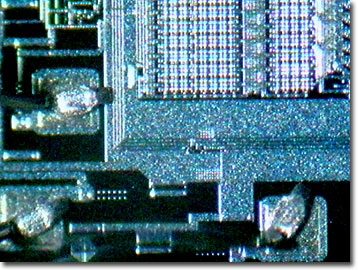Integrated Circuit Image Gallery
Intel 8087 Math Coprocessor
Released in 1980, the Intel 8087 is the math coprocessor designed to accompany the 16-bit 8086 and 8088 microprocessors. The 8087 fits into a 40-pin dual in-line package (DIP) socket that provides the chip with the same addressing and data handling capabilities as the CPU it matches.

While the 8087 coprocessor can accept data from a 16-bit bus, it also works without modification on the 8-bit bus of the 8088, automatically adapting as necessary. Three versions of the 8087 were produced. The original chip, the basic 8087, was designed to operate at system clock speeds up to 5 MHz and was suitable without any modifications for IBM PCs and XTs and compatible personal computers. The 8087-2 operated at speeds up to 8 MHz as required by IBM PS/2s and "turbo" XTs while the 8087-1 performed at 10 MHz clock speeds. The clever architecture also accommodates the more advanced 80186 and 80188 processors.
Because the limitations of the 1980 3.0-micron technology were pressed to the limit by the tens of thousands of transistors and complex circuitry of the 8086 and 8088, it was practical for semiconductor manufacturers to omit the advanced math functions from the 8086 and 8088 designs. Instead, the useful and very marketable math functions were relegated to a separate element, which was eventually produced as a commercial product, the 8087 math coprocessor (two years after the release of the 8086). Intel claimed it was the most complex large-scale integrated circuit commercially manufactured at the date of release. The "i" silk-screened onto the ceramic package indicates that Intel produced the chip instead of one of its licensed manufacturers.
Complex or not, the 8087 math coprocessor could not stand on its own and needed an 8086 or 8088 processor to function. The designers retained the interfacing and control circuitry on the main processor. When the main microprocessor came across a numeric coprocessor command, the processor passed it onto the 8087 chip and told it which data to address. After the coprocessor calculated the answer, it passed the results back to 8086 or 8088 chip for further processing or display.
Contributing Authors
Omar Alvarado, Thomas J. Fellers and Michael W. Davidson - National High Magnetic Field Laboratory, 1800 East Paul Dirac Dr., The Florida State University, Tallahassee, Florida, 32310.
BACK TO THE INTEGRATED CIRCUIT IMAGE GALLERY
BACK TO THE DIGITAL IMAGE GALLERIES
Questions or comments? Send us an email.
© 1995-2025 by Michael W. Davidson and The Florida State University. All Rights Reserved. No images, graphics, software, scripts, or applets may be reproduced or used in any manner without permission from the copyright holders. Use of this website means you agree to all of the Legal Terms and Conditions set forth by the owners.
This website is maintained by our
Graphics & Web Programming Team
in collaboration with Optical Microscopy at the
National High Magnetic Field Laboratory.
Last Modification Friday, Nov 13, 2015 at 01:19 PM
Access Count Since September 17, 2002: 15641
Visit the website of our partner in introductory microscopy education:
|
|
